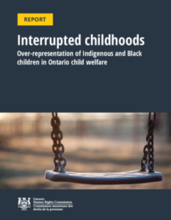Summary and key findings
For decades, Indigenous, Black and other racialized families and communities have raised the alarm that their children are over-represented in the child welfare system. Although Indigenous and racialized children’s pathways through the system are quite different, Ontario-based research shows that racial disparities – that is, differences between racial groups at decision-making points in a service – do exist. The number of Indigenous children in care is staggering, and the Truth and Reconciliation Commission of Canada (TRC) has called the situation a “growing crisis.”
The issues that give rise to the over-representation of Indigenous and Black children in the child welfare system are complex and multi-faceted. For example, low income, which is one of the inter-generational effects of colonialism, slavery and racism in society, is a major driver of child welfare involvement for Indigenous and Black children. Many Indigenous, Black and other racialized families, communities, advocates and others are also concerned that systemic racial discrimination in the child welfare system plays a significant role.
The OHRC’s inquiry
To respond to these concerns, in 2016 the Ontario Human Rights Commission (OHRC) launched a public interest inquiry to examine the involvement of Indigenous and racialized children and youth in the child welfare system. We used our powers under s. 31 of the Ontario Human Rights Code to request information from children’s aid societies (CASs) on their race-based data collection practices and how they track children and families receiving their services.
The goal was to examine whether Indigenous and Black children are over-represented at CASs, particularly in admissions into care. We were concerned because racial disproportionality (the over- or under-representation of certain racial groups in a service relative to their proportion in the general population) and racial disparity may be indicators of systemic racial discrimination. This report discusses the results of this analysis, and describes the human rights-based data collection practices CASs use.

